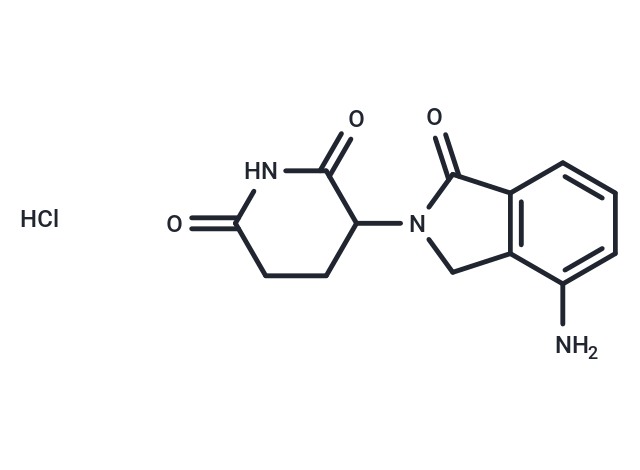Shopping Cart
- Remove All
 Your shopping cart is currently empty
Your shopping cart is currently empty

Lenalidomide hydrochloride (CC-5013 hydrochloride), a Thalidomide derivative, functions as molecular glue and serves as an orally active immunomodulator. As a ligand for the ubiquitin E3 ligase cereblon (CRBN), it facilitates the selective ubiquitination and degradation of the lymphoid transcription factors IKZF1 and IKZF3 through the CRBN-CRL4 ubiquitin ligase. Specifically, Lenalidomide hydrochloride inhibits the growth of mature B-cell lymphomas, including multiple myeloma, and promotes IL-2 release from T cells [1] [2].

| Pack Size | Price | Availability | Quantity |
|---|---|---|---|
| 25 mg | $1,520 | 1-2 weeks | |
| 50 mg | $1,980 | 1-2 weeks | |
| 100 mg | $2,500 | 1-2 weeks |
| Description | Lenalidomide hydrochloride (CC-5013 hydrochloride), a Thalidomide derivative, functions as molecular glue and serves as an orally active immunomodulator. As a ligand for the ubiquitin E3 ligase cereblon (CRBN), it facilitates the selective ubiquitination and degradation of the lymphoid transcription factors IKZF1 and IKZF3 through the CRBN-CRL4 ubiquitin ligase. Specifically, Lenalidomide hydrochloride inhibits the growth of mature B-cell lymphomas, including multiple myeloma, and promotes IL-2 release from T cells [1] [2]. |
| In vitro | Lenalidomide, a thalidomide analog, is effective in enhancing T cell proliferation and the production of IFN-γ and IL-2, while simultaneously inhibiting the generation of pro-inflammatory cytokines (TNF-α, IL-1, IL-6, IL-12) and increasing anti-inflammatory IL-10 levels in human PBMCs. It directly reduces IL-6 production and disrupts the interaction between multiple myeloma (MM) cells and bone marrow stromal cells (BMSC), leading to increased apoptosis of myeloma cells. Furthermore, lenalidomide, along with Thalidomide and Pomalidomide, demonstrates a dose-dependent interaction with the CRBN-DDB1 complex, showing specificity in inhibiting cell proliferation, particularly in cells expressing reduced levels of CRBN. Notably, lenalidomide acts as a molecular bridge promoting the ubiquitination and degradation of CKIα by facilitating its connection with the cereblon E3 ubiquitin ligase, potentially activating p53 to target leukemic cells for destruction. |
| In vivo | Lenalidomide, administered through intravenous (IV), intraperitoneal (IP), and oral (PO) routes at doses up to 15 mg/kg, 22.5 mg/kg, and 45 mg/kg, demonstrates acceptable toxicity profiles. The compound's solubility in a Phosphate Buffered Saline (PBS) dosing vehicle constrains the maximum doses. Despite this limitation, the doses are generally well tolerated, except for a single mortality observed in one mouse (of four total dosed) at the 15 mg/kg IV dosage. No additional toxicities were noted at IV doses of 15 mg/kg (n=3) or 10 mg/kg (n=45), nor at any levels across the studied administration routes [4]. |
| Molecular Weight | 295.72 |
| Formula | C13H14ClN3O3 |
| Cas No. | 1243329-97-6 |
| Relative Density. | 1.31g/cm3 |
| Storage | Powder: -20°C for 3 years | In solvent: -80°C for 1 year | Shipping with blue ice. |

Copyright © 2015-2025 TargetMol Chemicals Inc. All Rights Reserved.